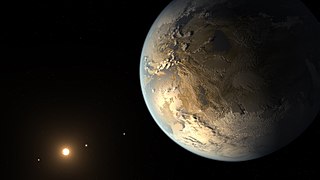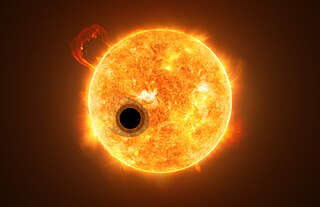
This is a list of exoplanets. As of 1 July 2022, there are 5,108 confirmed exoplanets in 3,779 planetary systems, with 826 systems having more than one planet. Most of these were discovered by the Kepler space telescope. There are an additional 2,058 potential exoplanets from Kepler's first mission yet to be confirmed, as well as 1,024 from its "Second Light" mission and 3,505 from the Transiting Exoplanet Survey Satellite (TESS) mission.
Pi Mensae, also known as HD 39091, is a yellow dwarf star in the constellation of Mensa. This star has a high proper motion. The apparent magnitude is 5.67, which can be visible to the naked eye in exceptionally dark, clear skies. It is nearly 60 light-years away. The star is slightly larger than the Sun in terms of mass, size, luminosity, temperature and metallicity, and is about 730 million years younger. It hosts two known planets.

WASP-12b is a hot Jupiter orbiting the star WASP-12, discovered on April 1, 2008, by the SuperWASP planetary transit survey. The planet takes only a little over one Earth day to orbit its star, in contrast to about 365.25 days for the Earth to orbit the Sun. Its distance from the star (approximately 3.5 million kilometers is only the Earth's distance from the Sun, with an eccentricity the same as Jupiter's. Consequently, it has one of the lowest densities for exoplanets. On December 3, 2013, scientists working with the Hubble Space Telescope reported detecting water in the atmosphere of the exoplanet. In July 2014, NASA announced finding very dry atmospheres on three exoplanets orbiting sun-like stars.

Transiting Exoplanet Survey Satellite is a space telescope for NASA's Explorer program, designed to search for exoplanets using the transit method in an area 400 times larger than that covered by the Kepler mission. It was launched on 18 April 2018, atop a Falcon 9 launch vehicle and was placed into a highly elliptical 13.70-day orbit around the Earth. The first light image from TESS was taken on 7 August 2018, and released publicly on 17 September 2018.

HAT-P-14b, also known as 'WASP-27b', is an extrasolar planet located approximately 250 parsecs (820 ly) away in the constellation of Hercules, orbiting the 10th magnitude F-type star HAT-P-14. This planet was discovered in 2010 by the HATNet Project using the transit method. It was independently detected by the SuperWASP project.

WASP-107b is a super-Neptune exoplanet that orbits the star WASP-107. It lies 200 light-years away from Earth in the constellation Virgo. Its discovery was announced in 2017 by a team led by D. R. Anderson via the WASP-South.

HD 21749 is an orange main-sequence star about 0.68 the mass of the Sun in the constellation Reticulum, located about 53 ly (16 pc) from Earth. On 7 January 2019, it was announced that the star has two exoplanets: a possibly rocky, hot sub-Neptune-sized exoplanet, named HD 21749b; and, a sub-Earth exoplanet, tentatively named HD 21749c. These exoplanets were discovered by the Transiting Exoplanet Survey Satellite (TESS).

GJ 357 is an M-type main sequence star with an unusually low starspot activity. It is located 31 light-years from the Solar System.
TOI 700 is a red dwarf 101.4 light-years away from Earth located in the Dorado constellation that hosts TOI 700 d, the first Earth-sized exoplanet in the habitable zone discovered by the Transiting Exoplanet Survey Satellite (TESS).
TOI 700 d is a near-Earth-sized exoplanet, likely rocky, orbiting within the habitable zone of the red dwarf TOI 700, the outermost planet within the system. It is located roughly 101.4 light-years (31.1 pc) away from Earth in the constellation of Dorado. The exoplanet is the first Earth-sized exoplanet in the habitable zone discovered by the Transiting Exoplanet Survey Satellite (TESS).
TOI 561 is an old, metal-poor Sun-like star, known to have multiple small planets. It is an orange dwarf, estimated to be 10.5 billion years old, and about 79% the mass and 85% the radius of Sol, Earth's sun.
Kepler-411 is a binary star system. Its primary star Kepler-411 is a K-type main-sequence star, orbited by the red dwarf star Kepler-411B on a wide orbit, discovered in 2012.
TOI-628 b is an exoplanet whose mass is 6.33 times that of Jupiter. It has an orbital period of 3.4 days and was discovered by TESS in January 2021. It is located 583 light years away from Earth.
TOI-640 b is an exoplanet that was discovered by TESS in January 2021. It is located 1115 light years away from Earth and has an orbital period of 5 days.
TOI-1333 b is an exoplanet that has an orbital period of 4.7 days. It is located 654 light years away from Earth and was discovered by TESS in January 2021.
TOI-1601 b is an exoplanet that was discovered by TESS in January 2021. It has an orbital period of 5.3 days and is located 1098 light years away from Earth. It also has a mass similar to that of Jupiter.






